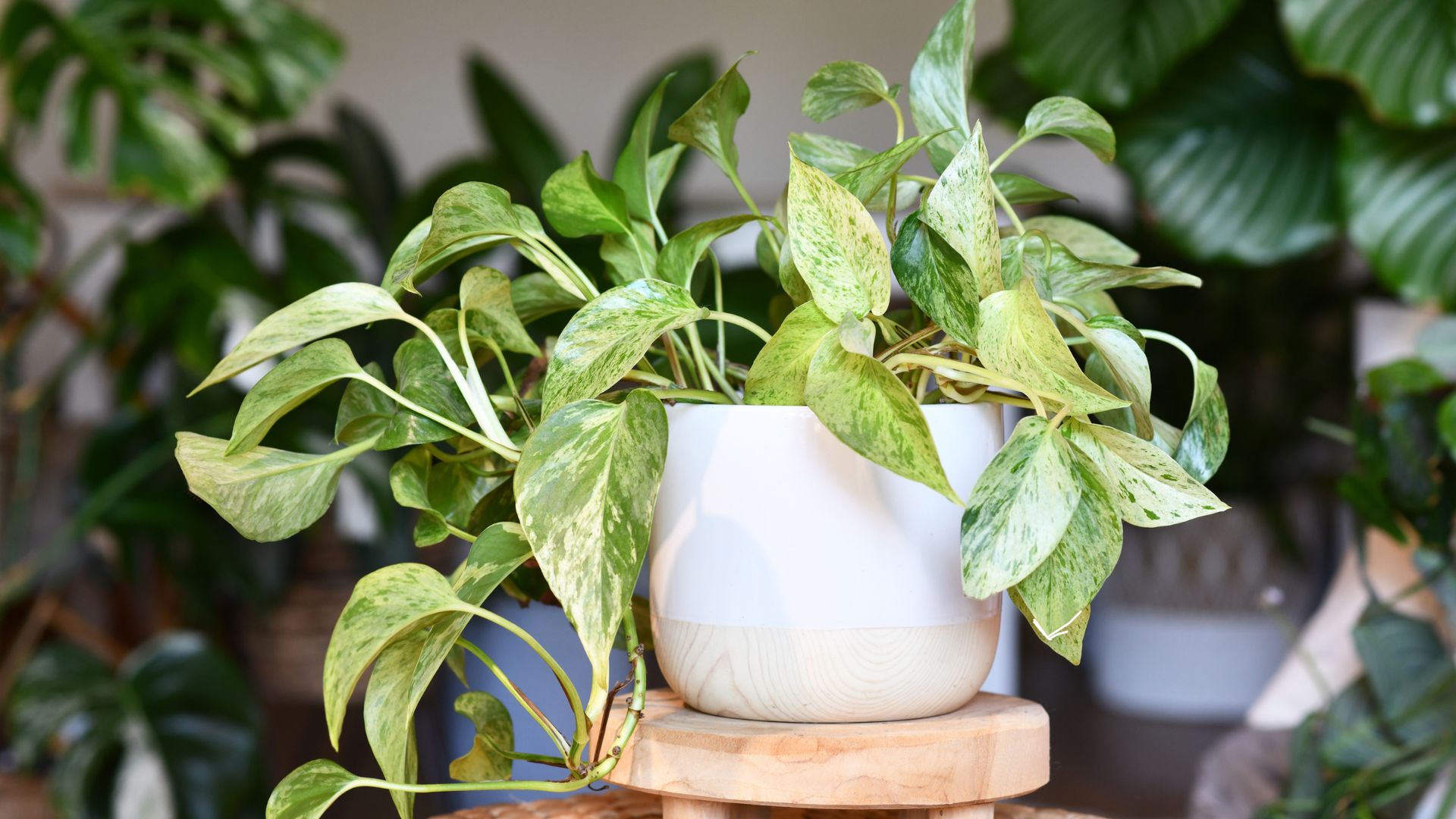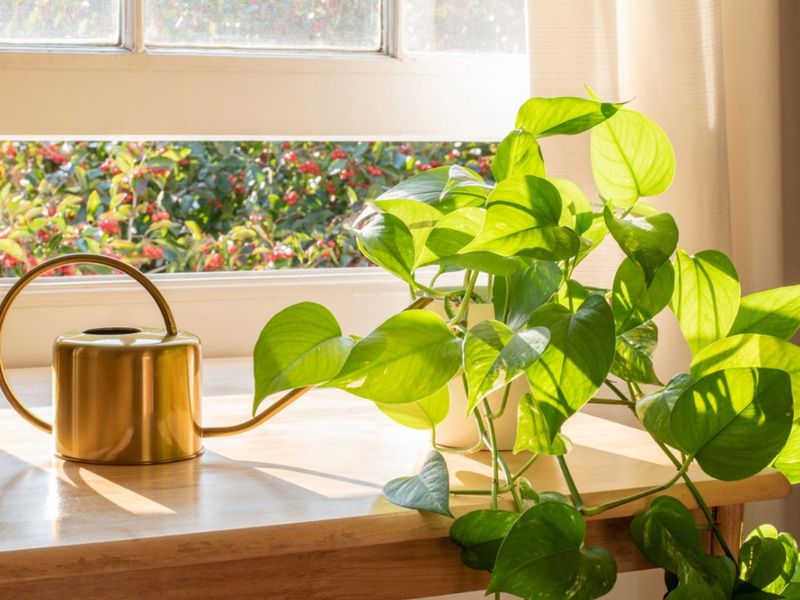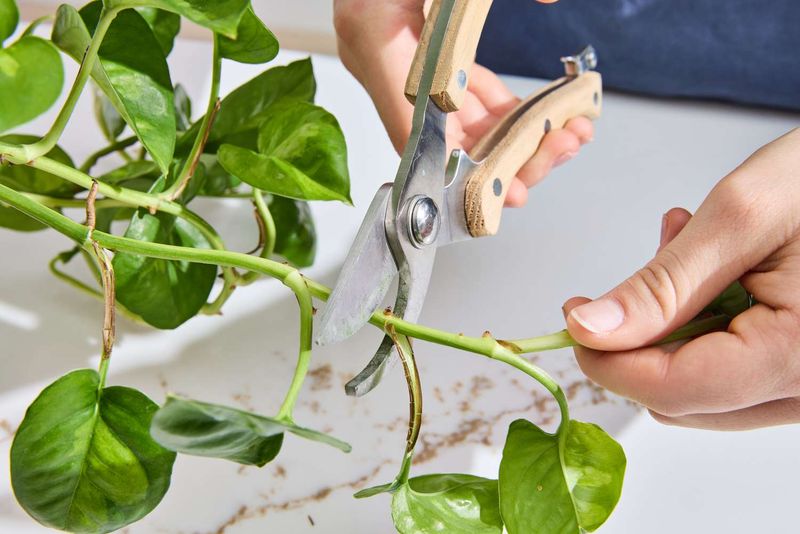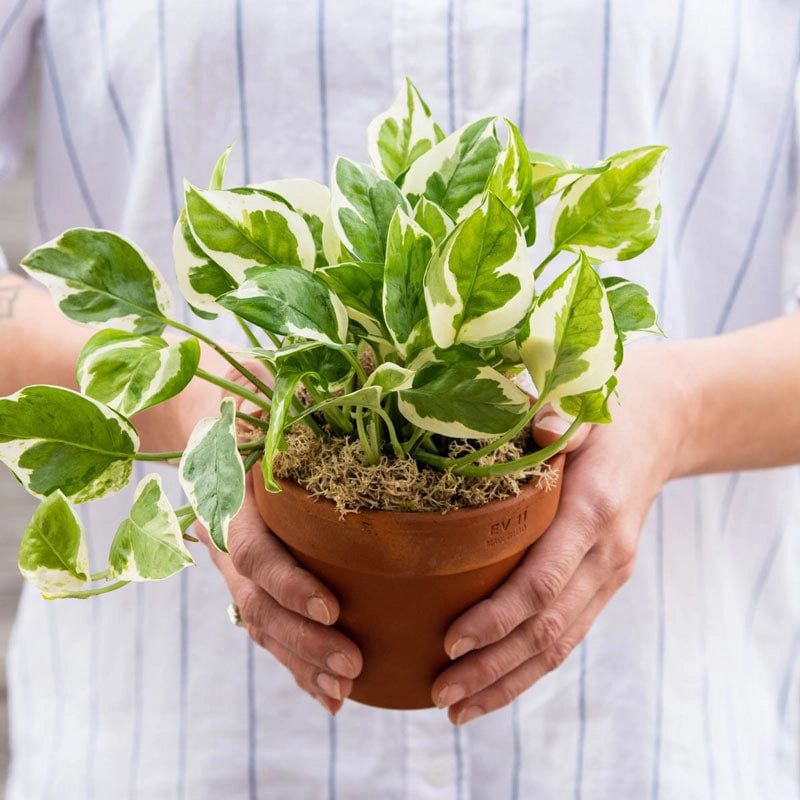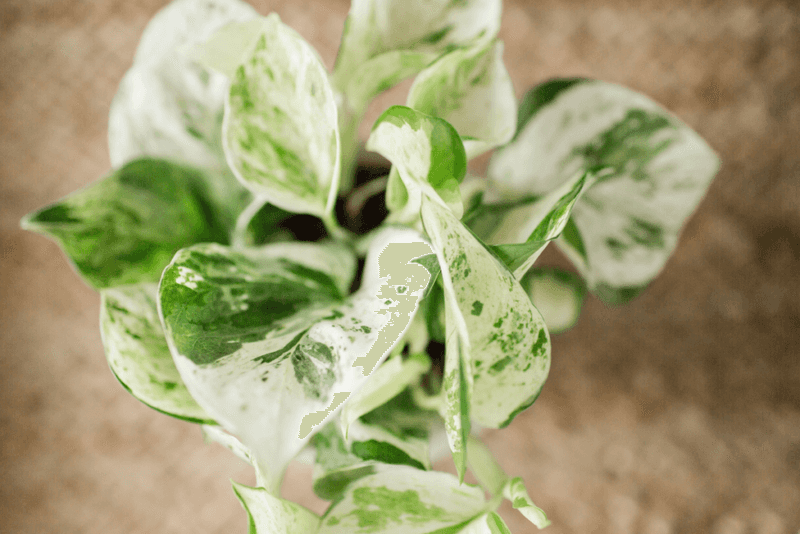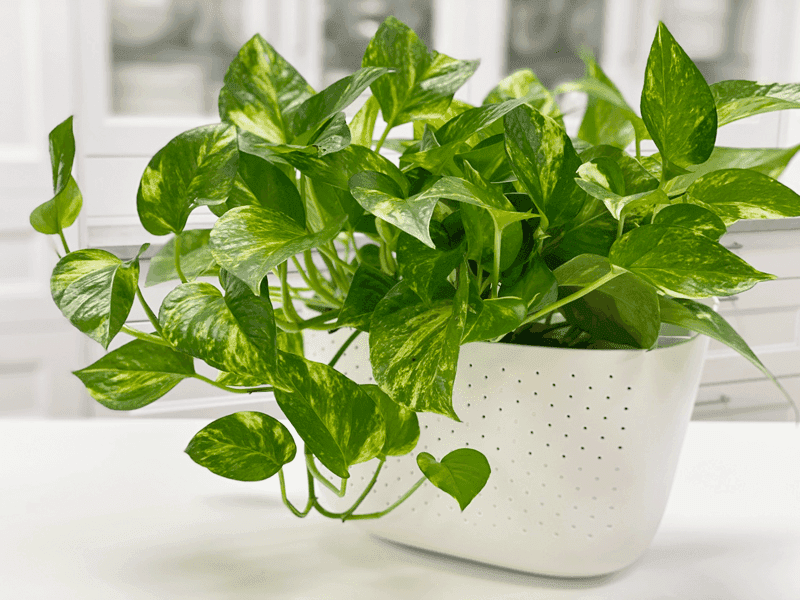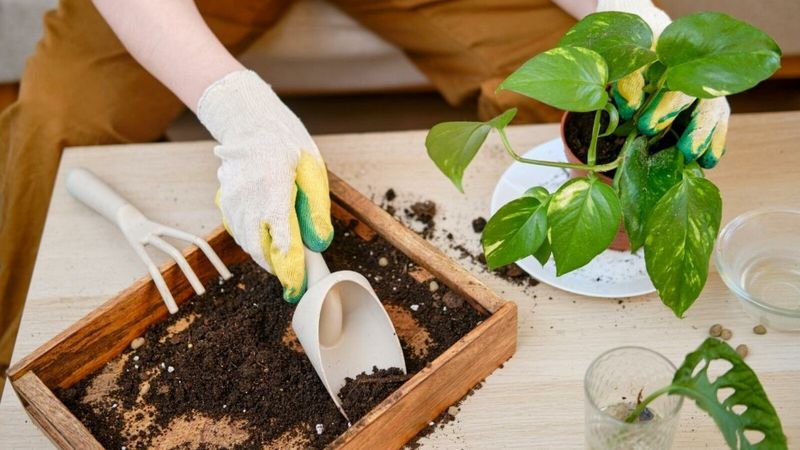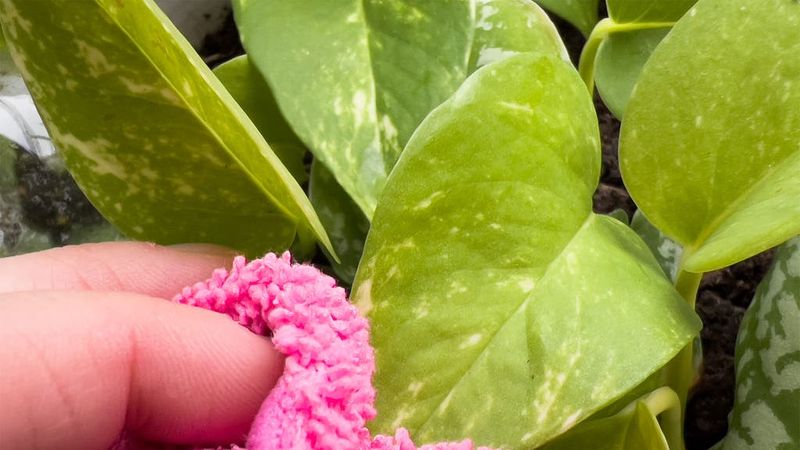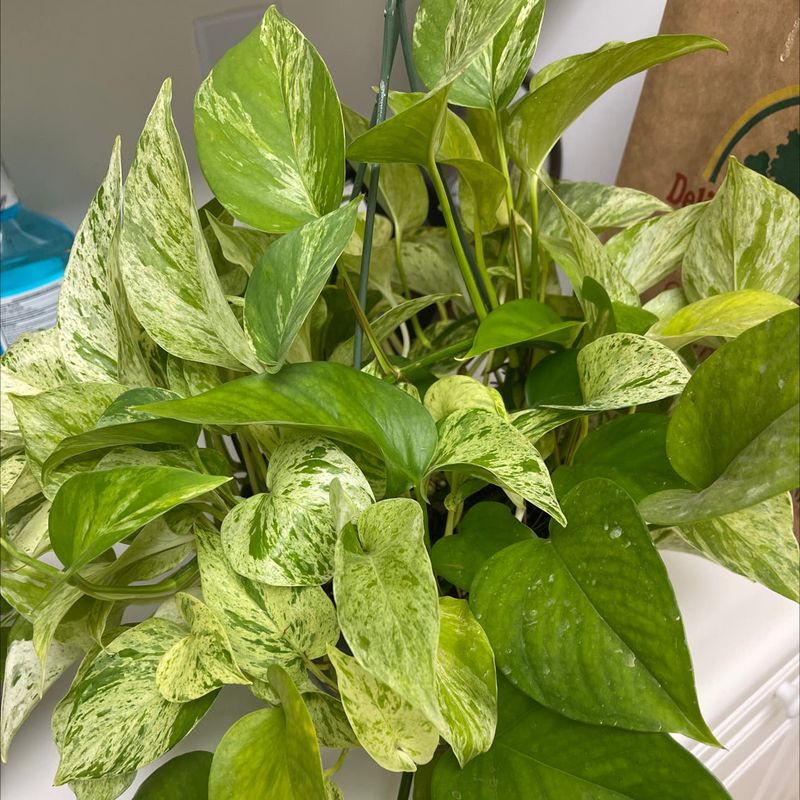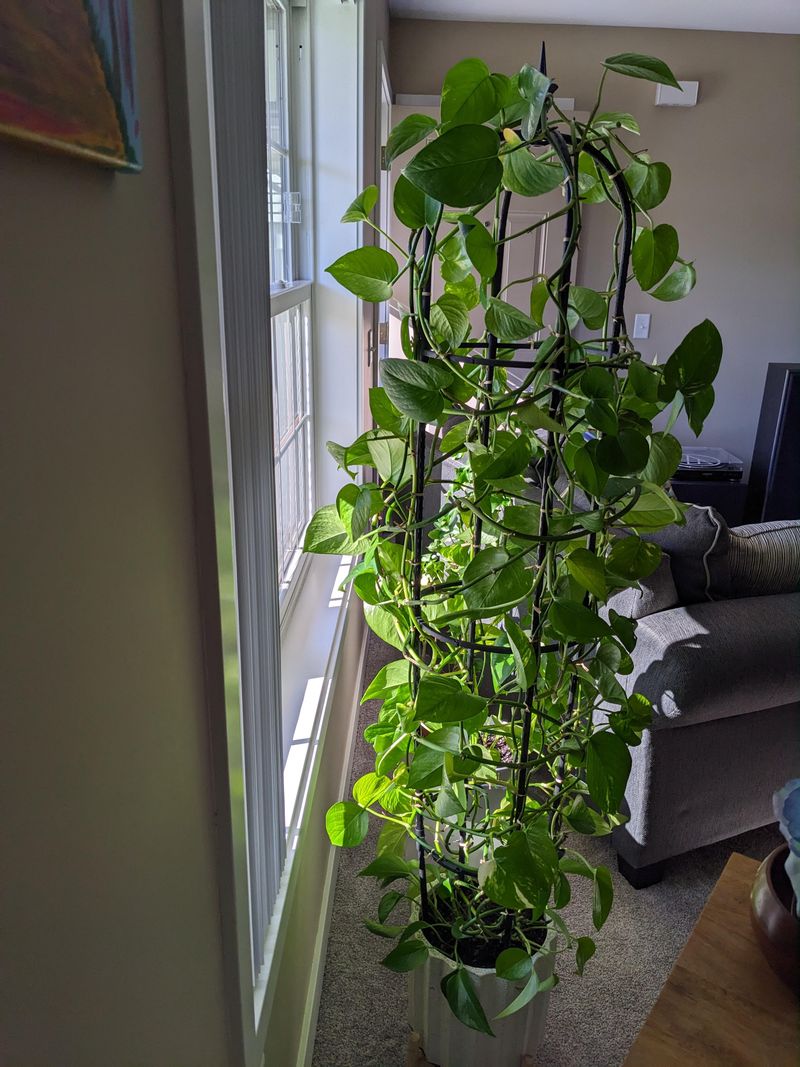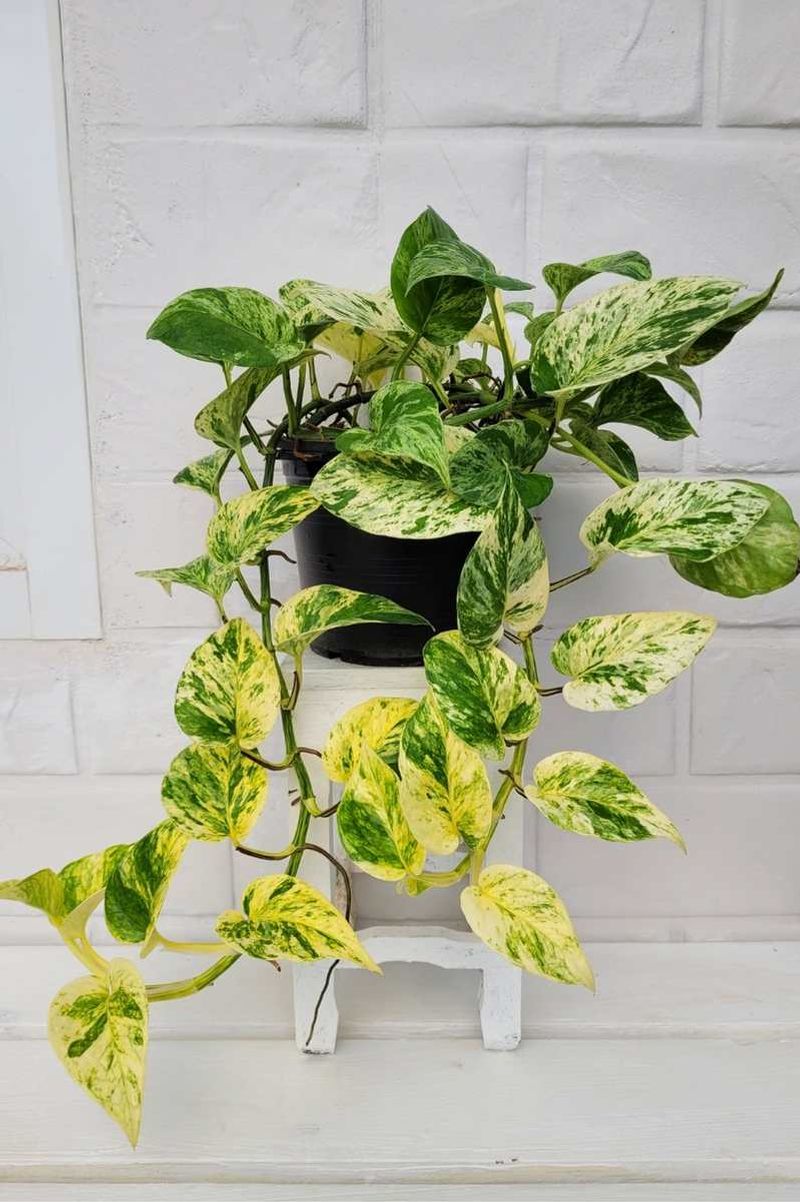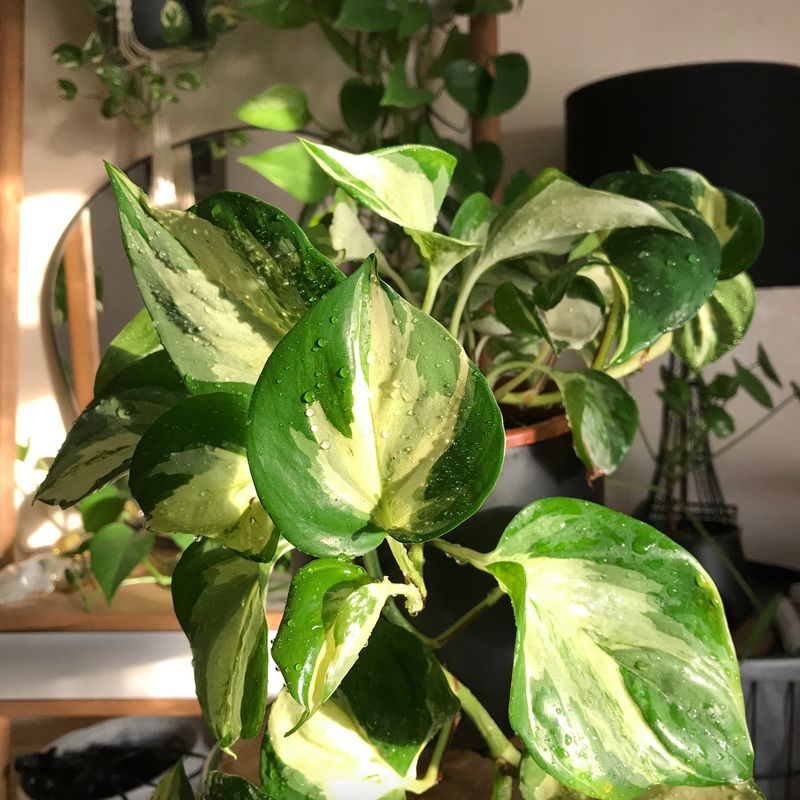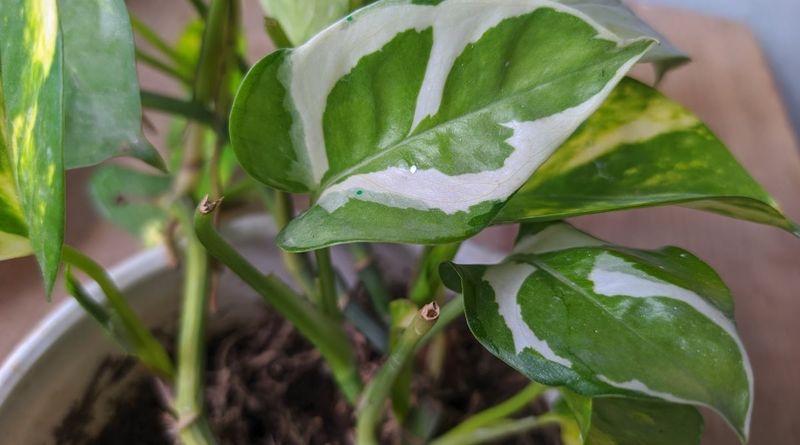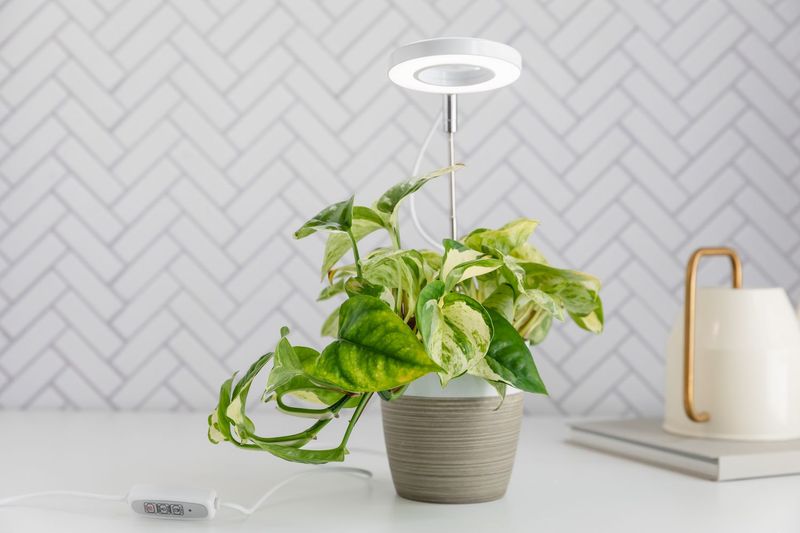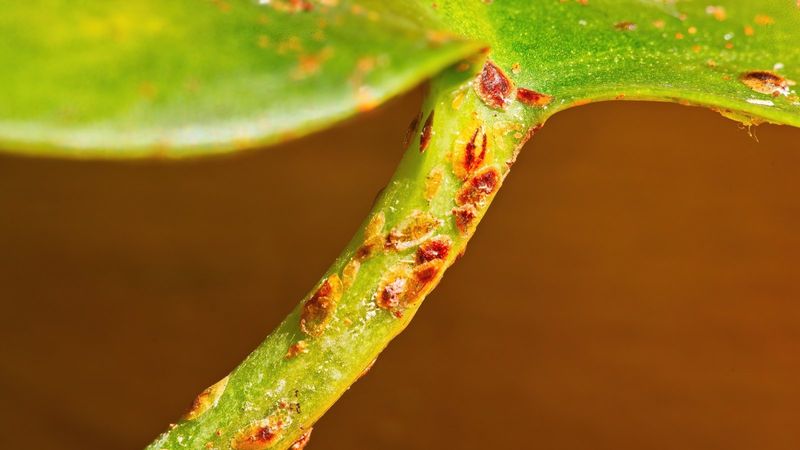Pothos plants are the kind of houseplant that make you feel like you can keep something alive—even if you’ve killed a cactus before. But if you’ve ever noticed those bold variegated patterns starting to fade or go fully green, it can feel a little disappointing (and a bit confusing).
Luckily, keeping those colors vibrant isn’t about fancy plant formulas or complicated care routines. With just a few small tweaks—like adjusting lighting or understanding how the plant naturally grows—you can help your pothos show off its best side again.
Let’s find what causes variegation to fade, and more importantly, how to bring that beauty back without stressing your plant out.
1. Find The Perfect Light Balance
Pothos plants develop more variegation when they receive bright, indirect light. Too little light causes the plant to produce more chlorophyll (green pigment) to maximize photosynthesis, which reduces variegation. Too much direct sunlight can scorch those beautiful leaves.
Place your pothos near an east or north-facing window where it gets morning light but is protected from harsh afternoon rays. The balanced light exposure encourages the plant to maintain its natural color patterns without stressing the foliage.
If you notice variegation fading, gradually move your plant to a brighter spot over a week rather than making a sudden change. This gentle transition prevents shock while encouraging those beautiful cream, white, or yellow patterns to reemerge.
2. Rotate Your Plant Regularly
Plants naturally grow toward light sources, causing uneven development of variegation. The side facing away from light often becomes greener while the light-facing side maintains better color contrast. This one-sided growth can make your pothos look less impressive overall.
Give your pothos a quarter turn every week to ensure all parts receive similar light exposure. This simple habit promotes balanced growth and helps maintain consistent variegation across the entire plant, not just on one side.
Set a weekly reminder on your phone to turn your plant. Over time, you’ll notice more uniform coloration and a fuller, more symmetrical plant shape as all sides develop equally attractive variegation patterns.
3. Strategic Pruning Techniques
Sometimes your pothos produces stems with less variegation than others. These mostly-green sections grow faster and can eventually overtake the more colorful parts of your plant, leading to an overall reduction in variegation.
Identify stems with minimal variegation and prune them back to encourage growth from more variegated sections. Use clean, sharp scissors to make cuts just above a leaf node, which signals the plant to branch out from that point.
Focus your pruning efforts during the growing season (spring and summer) when your pothos can recover quickly. This selective approach allows you to gradually shape your plant toward more colorful growth while maintaining its overall health and vigor.
4. Control Fertilizer Application
Heavy fertilizing promotes lush green growth but often at the expense of variegation. Nitrogen especially encourages chlorophyll production, which can overwhelm the white, cream, or yellow areas in variegated leaves.
Feed your pothos with a balanced houseplant fertilizer at half the recommended strength during the growing season. Apply it just once every 6-8 weeks rather than following the more frequent schedule suggested on the package.
During fall and winter, stop fertilizing altogether to avoid pushing green growth when the plant naturally slows down. This restrained approach maintains the plant’s health while preventing the variegation from being “greened out” by excessive nutrients.
5. Manage Watering Cycles
Overwatering stresses pothos plants and can cause them to revert to producing more green growth as a survival mechanism. When roots sit in soggy soil, they struggle to absorb nutrients properly, throwing off the plant’s natural variegation processes.
Allow the top 1-2 inches of soil to dry out completely between waterings. This creates a healthy root environment that supports the plant’s natural variegation patterns without triggering stress responses that favor green growth.
Water thoroughly until it drains from the bottom, then empty the saucer immediately. This method prevents both drought stress and waterlogging—both of which can cause your pothos to lose its beautiful color patterns as it tries to compensate.
6. Choose The Right Pot Size
Pothos plants placed in oversized containers often focus energy on root development rather than maintaining leaf variegation. The extra soil holds excess moisture, creating stress that can cause the plant to produce more chlorophyll as a survival response.
Select a pot that’s just 1-2 inches wider than the current root ball. This snug fit encourages the plant to maintain its decorative qualities instead of diverting resources to filling a large container with roots.
When repotting, gently loosen the root ball rather than breaking it apart. This minimal-disturbance approach reduces transplant shock that might trigger a loss of variegation as the plant recovers.
7. Propagate From Highly Variegated Cuttings
Not all pothos stems show the same level of variegation. By selectively propagating the most colorful sections, you can develop new plants with enhanced color patterns compared to the parent plant.
Choose stems with exceptional variegation for propagation. Cut just below a node with clean scissors, ensuring your cutting has at least 2-3 leaves with the color pattern you’re trying to achieve.
Root your cuttings in water or moist soil, placing them in bright indirect light to maintain their variegation as they develop. Once established, these new plants will carry forward the more dramatic color patterns you selected, creating a more visually striking pothos collection.
8. Maintain Optimal Temperature Range
Temperature extremes can stress pothos plants and affect their variegation. Cold drafts or sudden temperature drops often cause leaves to develop more green areas as the plant attempts to increase photosynthesis for survival.
Keep your pothos in a location with consistent temperatures between 65-85°F (18-29°C). Avoid placing it near heating vents, air conditioners, or drafty windows where temperature fluctuations occur.
During winter, move plants a few inches away from windows at night to protect them from cold glass surfaces. This temperature stability helps your pothos maintain its natural variegation patterns without triggering stress responses that diminish those beautiful color contrasts.
9. Use Appropriate Soil Mix
Heavy, dense potting mixes retain too much moisture and can suffocate roots, causing stress that affects variegation. When roots can’t breathe properly, the plant focuses on survival rather than maintaining decorative leaf patterns.
Create a light, airy potting mix by combining regular potting soil with perlite and orchid bark in equal parts. This mixture provides excellent drainage while still retaining enough moisture for healthy growth without waterlogging.
When repotting, gently shake off some of the old soil and replace it with this well-draining mix. The improved root environment reduces stress factors that might cause your pothos to revert to more green growth, helping preserve those striking variegated patterns.
10. Clean Leaves Regularly
Dust accumulation on leaves blocks light absorption and can diminish variegation over time. The layer of dust acts like a filter, reducing the amount of light reaching the leaf surface and interfering with the plant’s ability to maintain its color patterns.
Wipe leaves gently with a soft, damp cloth once a month to remove dust buildup. For smaller leaves, you can support them with one hand while wiping with the other to prevent tearing or damage to the delicate tissue.
Avoid using leaf shine products or oils that can clog the leaf pores. A simple wipe with plain water is all that’s needed to keep the leaves clean and maximize light absorption, which helps maintain those beautiful variegation patterns.
11. Boost Humidity Strategically
Low humidity can stress pothos plants, causing leaf edges to brown and potentially affecting variegation patterns. When the air is too dry, plants conserve resources and may reduce the energy spent maintaining decorative leaf coloration.
Increase humidity around your pothos by placing it on a pebble tray filled with water (ensuring the pot sits on the pebbles, not in the water). This creates a humid microclimate without risking root rot from excess moisture in the soil.
Group your pothos with other houseplants to create a naturally humid environment through transpiration. This community approach benefits all your plants while avoiding the potential damage that can come from direct misting of variegated leaves.
12. Provide Gentle Support
Trailing pothos vines can become tangled or buried under other foliage, preventing some leaves from receiving adequate light. These shaded leaves often lose variegation as they produce more chlorophyll to compensate for reduced light exposure.
Use bamboo stakes, moss poles, or small trellises to gently train your pothos upward or outward. This strategic arrangement ensures all leaves receive similar light exposure, maintaining consistent variegation throughout the plant.
Reposition stems periodically without forcing them into unnatural positions. The goal is to create space between the foliage so light reaches all leaves equally, encouraging uniform variegation patterns across the entire plant.
13. Practice Selective Leaf Removal
Older leaves naturally show less variegation as they age, and damaged leaves divert energy from the plant’s overall health. These leaves contribute less to the plant’s appearance while still consuming resources that could support more colorful new growth.
Remove older, mostly green leaves and any damaged foliage by cutting them off at the base of their stems. This selective pruning redirects the plant’s energy toward producing new, more vibrantly variegated growth.
Limit removal to just a few leaves at a time, spaced out over several weeks. This gradual approach prevents shocking the plant while steadily improving its overall appearance as newer, more colorful leaves replace the removed foliage.
14. Adjust Seasonal Care
Pothos growth patterns change with the seasons, affecting how they maintain variegation. During winter, slower growth and lower light levels can cause variegation to fade if care routines aren’t adjusted accordingly.
Reduce watering frequency during fall and winter when growth naturally slows, but maintain consistent bright indirect light. This seasonal adjustment prevents the stress of overwatering while still providing the light needed to preserve variegation.
Move plants closer to light sources during shorter winter days, then readjust their position as daylight hours increase in spring. These seasonal adaptations help your pothos maintain its beautiful coloration year-round despite changing environmental conditions.
15. Monitor Root Health
Root problems often show up as changes in leaf coloration before other symptoms appear. When roots are unhealthy, the plant diverts energy to survival, often at the expense of maintaining variegation patterns.
Check root health whenever you notice variegation declining by gently removing the plant from its pot. Healthy roots should be firm and light-colored, not brown, mushy, or smelly, which indicate root rot that can affect leaf coloration.
Trim away any damaged roots with clean scissors before repotting in fresh soil. This root maintenance helps ensure your pothos can properly absorb nutrients and maintain its energy balance, supporting those beautiful variegated patterns you love.
16. Consider Light Supplementation
During darker winter months or in naturally low-light homes, pothos plants may struggle to maintain their variegation. The reduced light levels trigger increased chlorophyll production, causing those beautiful patterns to fade over time.
Supplement natural light with a simple grow light positioned 12-18 inches above your plant for 4-6 hours daily. Choose full-spectrum LED grow lights that mimic natural sunlight without producing excess heat that could damage the leaves.
Start with just a few hours of supplemental lighting and gradually increase as needed based on your plant’s response. This gentle approach provides the light energy needed for maintaining variegation without shocking the plant with sudden intense exposure.
17. Prevent Pest Infestations Early
Pest problems stress pothos plants and can lead to reduced variegation as the plant focuses energy on defense rather than maintaining decorative leaf patterns. Even minor infestations divert resources away from the processes that create those beautiful color variations.
Inspect your pothos weekly for early signs of pests like spider mites, mealybugs, or scale insects. Check both the top and undersides of leaves, as well as along stems where pests often hide before populations grow large.
Treat any suspicious spots immediately with a gentle solution of water and a drop of mild soap applied with a cotton swab. This early intervention prevents the stress of a major infestation that could cause your pothos to lose its stunning variegation as a survival response.

